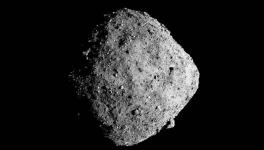Mars Rover Collects Rock Samples, Scientists Investigate Prospects of Ancient Life
Image Courtesy: .kqed.org
The Perseverance rover propelled by NASA (National Aeronautics and Space Administration) has provided desirable results till now in collecting rock-core samples. The rover has collected four samples of rock-core from an area named the Jezero Crater, where there existed a river delta billions of years ago.
Scientists are excited about the rock samples as these can open up prospects for finding signs of ancient microbial lives.
Thomas Zurbuchen, the associate administrator for science, NASA, commenting on the rock samples, said in a statement—“We picked the Jezero Crater for Perseverance to explore because we thought it had the best chance of providing scientifically excellent samples – and now we know we sent the rover to the right location. These first two science campaigns have yielded an amazing diversity of samples to bring back to Earth by the Mars Sample Return campaign.”
The Jezero Crater has a delta, an ancient feature formed some 3.5 billion years ago at the convergence of a Martian river and a lake. Perseverance is currently investigating the sedimentary rocks of the delta. These rocks had been formed by settling particles of various sizes in the delta when it got a watery environment. Perseverance also explored the floor of the crater in order to find igneous rocks formed deep underground during a volcanic activity at the surface.
Perseverance project scientist Ken Farley, in a NASA press release, commented—“The delta, with its diverse sedimentary rocks, contrasts beautifully with the igneous rocks – formed from the crystallisation of magma – discovered on the crater floor. This juxtaposition provides us with a rich understanding of the geologic history after the crater formed and a diverse sample suite. For example, we found a sandstone that carries grains and rock fragments created far from Jezero Crater – and a mudstone that includes intriguing organic compounds.”
In the coming years, NASA and ESA (European Space Agency) is planning to send another spacecraft to bring back the samples collected by Perseverance to Earth. Scientists will conduct further investigations with advanced laboratory techniques. These samples will be the first ever returned from Mars and are expected to be accomplished by 2033.
Organic molecules are primarily made up of carbon and also include hydrogen and oxygen atoms along with other elements like nitrogen, sulfur and phosphorus. The building blocks of life contain some of these elements, although the production of these compounds doesn't require life. The presence of these molecules is considered a potential signature of life.
In 2013 too, the Curiosity Mars rover of NASA found evidence of organic compounds in Martian rock samples. But unlike the previous discoveries, the latest comes from an area where sediments and salts were deposited in a lake in the distant past. This condition is potentially suitable for the existence of life in ancient times.
Perseverance landed in the Jezero Crater in February 2021. The 45 kilometres wide crater was the primary target of the rover to search for signatures of ancient lives where in the 3.5 billion years old river delta sediments turned into rocks.
Perseverance in its more than a year voyage to make way to the delta found igneous rocks formed from the eruption of volcanos on Jezero’s floor. In April 2022, scientists finally found what they were looking for—the sedimentary rocks. In the past few months, the rover collected different types of sedimentary rocks that made up the edge of the delta. The rover collected two pairs of cores, one from the Skinner ridge that is made up of sandstones similar to a type of rock found in many places on Earth.
The other pair comes from a spot known as the Wildcat Ridge, situated at a distance of just 20 meters from Wildcat Ridge. These samples are homogeneous and lighter in colour. Experts say that they seem to be mudstone, and they are even more fine-grained than the Skinner Ridge cores. Notably, the grains in a rock can be a signature of past lives. The finer the grains, the more likely it is to contain evidence of early lives, experts say.
“In the distant past, the sand, mud, and salts that now make up the Wildcat Ridge sample were deposited under conditions where life could potentially have thrived. The fact the organic matter was found in such a sedimentary rock – known for preserving fossils of ancient life here on Earth – is important. However, as capable as our instruments aboard Perseverance is, further conclusions regarding what is contained in the Wildcat Ridge sample will have to wait until it's returned to Earth for in-depth study as part of the agency's Mars Sample Return campaign," said Ken Farley in a NASA release.
Get the latest reports & analysis with people's perspective on Protests, movements & deep analytical videos, discussions of the current affairs in your Telegram app. Subscribe to NewsClick's Telegram channel & get Real-Time updates on stories, as they get published on our website.





















